What are Marsupials?
Contents
Marsupials are a group of mammals that give birth to tiny babies that complete their development, typically in a pouch, outside of the mother's womb. There are 334 species of marsupials worldwide. Of these, 234 live in Australia and New Guinea. The largest is the red kangaroo, which can grow to 2.1 meters in height. The smallest is the long-tailed planigale, which measure just 55-65 mm in length and weighing less than 5 grams.
List of Australian Marsupials
Koala
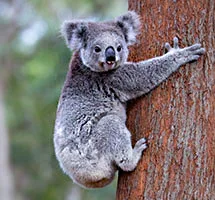
Koalas are cuddly tree-dwelling marsupials with large noses. Because of their teddy bear-like appearance, many people call them Koala Bears.
Read More about KoalasKangaroo
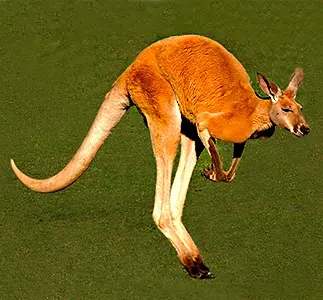
Kangaroos can hop at speeds up to 70kph and jump 2m into the air. They form small social groups called 'mobs' or 'troops'.
Read More about KangaroosQuokka
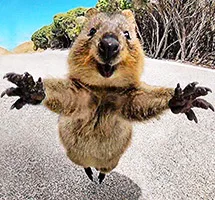
Quokkas seem like the happiest animals in the world. They are the size of a domestic cat and are almost extinct in the wild.
Read More about QuokkasTasmanian Devil
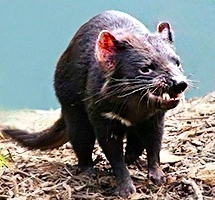
Tasmanian Devils are scary and boisterous marsupials with blood-curdling screams. They are extinct except on the island of Tasmania.
Read More about Tasmanian DevilsWallaby
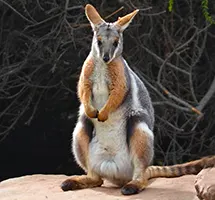
Wallabies are small to medium-sized hopping marsupials with compact legs built for agility in forested areas where they live.
Read More about WallabiesWombat
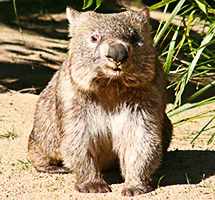
Wombats are burrowing s marsupials that look like baby bears. They have a backwards-facing pouch entrance and do cube-shaped poo!
Read More about WombatsSugar Glider
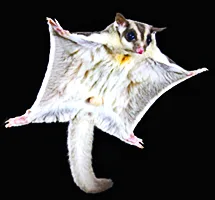
Sugar gliders are night possums that glide from tree to tree and eat the sugary nectar of plants. They are about 200-300mm long and very agile.
Read More about Sugar GlidersTasmanian Tiger
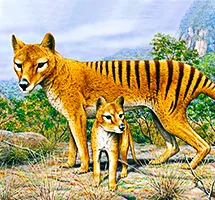
Tasmanian Tigers (Thylacine) were marsupial wolves that had stripes like a tiger. People hunted them to extinction. The last died in 1936.
Read More about Tasmanian TigersPossum
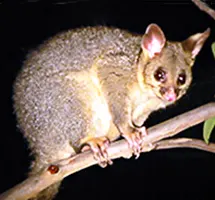
Australian Possums are nocturnal tree-dwelling marsupials. There are 23 species of possums in Australia. They are shy, solitary, territorial animals
Read More about PossumsNumbat
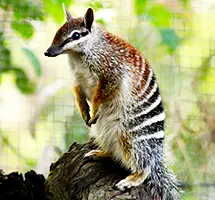
Numbats are small marsupial anteaters that eat termites. It has a pointed snout with a long sticky tongue to forage for termites.
Read More about NumbatsAntechinus
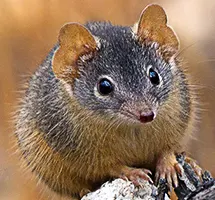
The Antechinus is a ferocious little marsupial mouse that feeds on small insects. It has a suicidal sexual behaviour.
Read More about AntechinusesRed Kangaroo
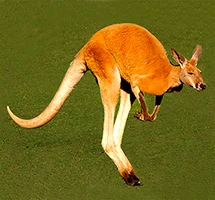
Red kangaroos are the largest marsupials and the largest hopping animal in the world. It can hop at over 60kph and leap 3 meters high.
Read More about Red KangaroosWoylie
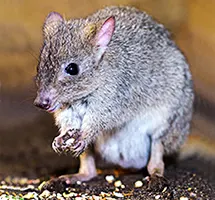
The woylie is a nocturnal marsupial with a long tail which it wraps around a bundle of nesting material and transports it home.
Read More about WoyliesLeadbeater's Possum
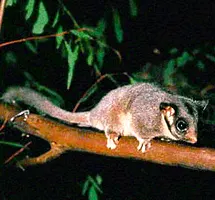
Leadbeater's Possums are fast-moving marsupials that live high in the forest canopy and leap gracefully from one tree to another.
Read More about LeadbeatersSpotted Quoll
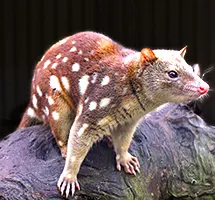
Spotted Tailed Quolls are the size of a large cat. They are the second-largest carnivorous marsupial and are endangered.
Read More about Spotted QuollsMusky Rat-Kangaroo
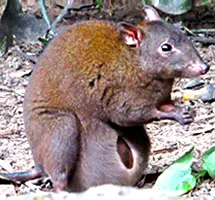
The Musky rat-kangaroo is the smallest macropod and the only kangaroo that doesn't hop. It lives in rainforests. As its name suggests, it looks a bit like a rat.
Read More about Rat-kangaroosMarsupial Mole
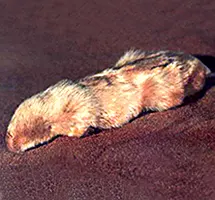
Marsupial Moles of the Australian desert spend their lives underground and have no eyes or ears. They have a bony shield to protect their noses.
Read More about Marsupial MolesGreater Bilby
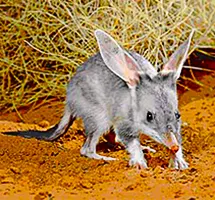
Greater bilbies are small nocturnal, omnivorous marsupials with rabbit-like ears and pointy pink snouts. Rabbit-sized, they live in the Outback.
Read More about BilbiesRingtail Possum
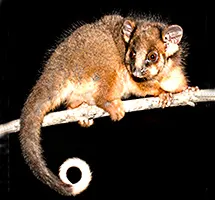
The Ringtail possum is a small arboreal, nocturnal marsupial that holds its tail in a tight coil. It has two thumbs on each front paws.
Read More about Ring Tail PossumsTree Kangaroo
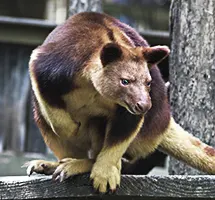
Tree Kangaroos live in trees. They climb by wrapping the forelimbs around a tree and hopping up with their powerful hind legs.
Read More about Tree KangaroosGilbert's potoroo
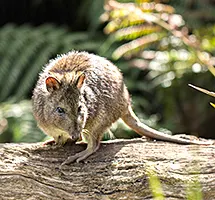
Gilbert's potoroo is the world's rarest marsupial. It has long front limbs with craved claws with which its digs for underground fungi (truffles).
Read More about Gilbert's PotoroosLesser Bilby
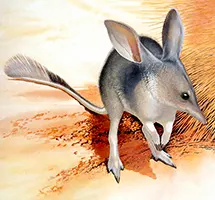
This small omnivorous marsupial became extinct in 1950 due to rabbits and introduced predators such as feral cats and foxes.
Read More about Lesser BilbiesAntilopine Kangaroo
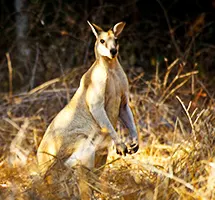
The antilopine kangaroo is the only kangaroo that lives entirely in the tropics. It has a face that looks like that of an antelope, hence its name.
Read More about AntilopineBandicoot
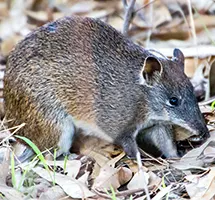
Bandicoots are small omnivorous marsupials with pointy snouts, large hind feet, and hop. There are 20 species of bandicoots in Australia.
Read More about BandicootsBushtail Possum

The brushtail possum is a semi-arboreal nocturnal marsupial. It has a bushy prehensile tail, which it uses to grasp onto branches.
Read More about BrushtailsStick Nest Rat
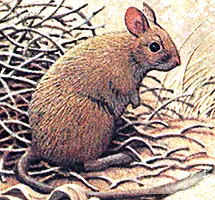
The white-tipped-stick-nest-rat builds its nest of sticks, which it added to over the years, making a massive nesting mound.
Read More about Stick Nest RatsLong-tail Planigale
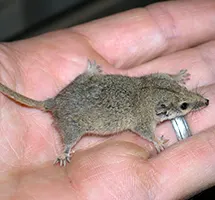
The long-tailed planigale looks like a tiny mouse with a long, bare tail. It has a tiny flattened head that allows to the squeeze into the smallest crevices. It weighs as much as a teaspoon of sugar.
Key Marsupial Characteristics
• Marsupials grow their baby in a pouch outside their body rather than in a womb like other mammals.
• Marsupial' s body temperature is approximately 3°C lower than that of placental mammals, and have basal metabolic rates that are about 30% lower. This adaptation helps them conserve energy and water, and making them exceptionally survivors in harsh environments. of around 35°C,
• Marsupials develop only one set of teeth in their lifetime—but they make it count by often boasting more teeth overall than their mammalian counterparts.
• Most marsupials are nocturnal, meaning they are active at night to avoid daytime heat, predators, and competition for food.
• Marsupials are typically solitary, and lack permanent social structures. Some, like kangaroos and wallabies, form loose casual groups called "mobs" when grazing.
• Most marsupials are capable swimmers, but only one species, the yapok of South America is truly aquatic.
Where Do Marsupials Live?
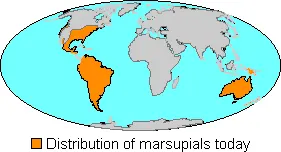
Marsupials live in Australia, New Guinea, southern USA, and Central and South America. Most Australian marsupials live in dry desert and shrub habitats, while American species are found in jungles and temperate zones.
What Do Marsupials Eat?
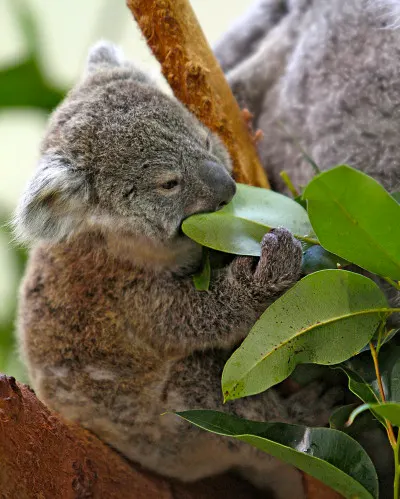
Photo: Koala feeding
Marsupials eat a wide variety of foods.
• Kangaroos, koalas and wombats, are herbivores, eating only plant matter.
• Bandicoots and possums, are omnivorous, eating plants and animals.
• The Tasmanian devil and the now-extinct Tasmanian tiger are carnivorous, eating only meat.
• Others are insectivores, consuming only insects.
Because marsupials' body temperature and metabolic rates are lower than comparable placental mammals, they require less energy. As a result, they need less food to survive. They also require less water than comparably sized placental mammals.
How do Marsupials Move?
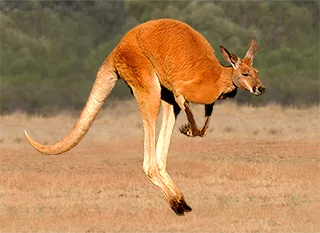
Photo Kangaroo - Bipedal Locomotion
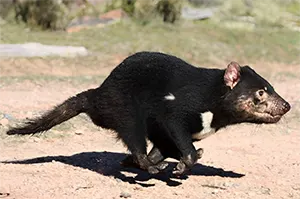
Photo: Tasmanian Devil - Quadrupedal Locomotion
Marsupials use various forms of locomotion:
• Bipedal (two legs) hopping: Macropods, a group of marsupials that include kangaroos, wallabies, and bandicoots, use bipedal hopping as their mode of locomotion.
• Quadrupedal (four legs) walking: Wombats, Tasmanian devils walk on all four legs.
• Gliding Sugar gliders glide from tree to tree. But there are no flying marsupials.
• Burrowing: Marsupial moles and wombats burrow as well as walk on four legs.
Marsupial Sexual Anatomy and Reproduction
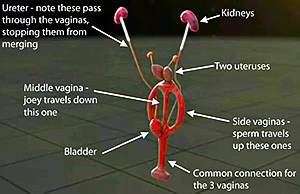
Photo: Marsupial Reproductive Anatomy
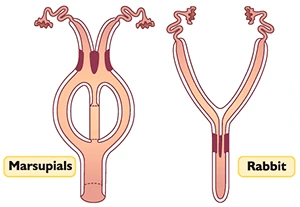
Photo: Placental Reproductive Anatomy
Male Marsupial
Most male marsupials such as the koala, have a bifurcated penis. That is, the penial shaft splits into two prongs at the end to enter the two separate lateral sexual vaginas of the female. However, macropods and the marsupial mole have a slender tapering single-shaft penis, which enters only one of the two lateral sexual vaginas of the female. Also, a marsupial's penis is located behind its scrotum. (Most animals have the penis located in front). When flaccid, the penis is withdrawn into the body.
Female Marsupial
The female marsupial has three vaginas and two uteruses (uteri). The two outermost vaginas are used for sperm transportation to its two uteruses. Babies are born through the middle vagina. By contrast, female placental mammals have only one uterus and one vagina. (See diagrams). With this unique reproductive system, some female marsupials, such as the kangaroo, can be in a continuous state of pregnancy, with a fertilised egg in one uterus waiting to be released, a baby growing in the second uterus, one in her pouch and another hopping outside but coming to its mother for milk.
Marsupial Birth Video

Baby Marsupial
The young marsupial, ranging in size from no larger than a grain of rice to about the size of a jelly-bean, soon emerges from the birth canal. Using its tiny forelimbs, the young joey crawls laboriously to its mother's fur to the pouch. Once inside its mother's pouch, the joey quickly attaches itself firmly to a nipple in the pouch.
Once it has attached itself to a nipple, the young joey will stay hidden until its starts to tentatively pop its head out of its mother's pouch and observe the world around it. Once it has gained enough confidence, it will venture outside.
This reproductive cycle is unlike placental mammals, which nourish their offspring for much longer through a placenta in the womb before giving birth to more developed young.
25 Fascinating Marsupial Facts
- Marsupial animals carry their babies in a pouch outside their bodies.
- They give birth to tiny underdeveloped babies and carry and nurse them in this pouch.
- There are only 330 species of marsupial.
- 75% of all marsupials in the world live in Australia. The rest live in the Americas.
- The word Marsupial (mar-sue-pee-al) comes from the Latin word “marsupium” which means pouch.
- Not all marsupials have pouches. A few have just a fold of skin.
- The smallest marsupial, the long-tailed planigale, weighing 4gm, as much as a teaspoon of sugar.
- The largest marsupial, the red kangaroo, is 2m tall and weighs 90kgs.
- Marsupials originated on a super-continent called Gondwana, which was made up of Australia, Antarctica and South America.
- This continent broke up millions of years ago, and Australia got isolated, and marsupials survived. They went mostly extinct elsewhere.
- There are no aquatic marsupials in Australia (There is one in South America).
- This is because a marsupial's pouch would get flooded, and the babies would drown.
- There are no flying marsupials.
- They have a body temperature about 3°C lower than placental mammals.
- Marsupials' basal metabolic rate is 30% lower than placental mammals.
- Because of their lower body temperature and metabolism, they are not found in very cold climates.
- Almost all marsupials are nocturnal.
- Marsupials, in general, have more teeth than placental mammals.
- They don't grow milk teeth.
- Female marsupials have three vaginas and two uteruses.
- Most male marsupials have a two-pronged penis.
- The gestation period for a marsupial is very short compared to placental mammals.
- A young marsupial, when its born, ranges in size from a grain of rice to the size of a jelly-bean.
- They crawl from the mother's birth canal into her pouch.
- Once it has attached itself to its mother's nipple, the baby will stay hidden for up to six months.
How Marsupials Migrated to Australia

It was once thought that marsupials originated in Australia. But recent fossil evidence and genetic research suggest that they may have originated in what is now modern-day China on the ancient landmass known as Pangaea (See map). About 200-180 million years ago, Pangaea broke into two continents. These were Laurasia with North America, Europe, China, and parts of Asia and Gondwana with South America, Africa, Antarctica, Australia, and India. Marsupials are believed to have arrived in Australia around 50 million years ago via North America, South America, and Antarctica.
When Australia separated from the other continents and started to drift southward, the marsupials stranded in Australia didn't have any competition from placental mammals. Without competition, the marsupials diverged into over 235 different species found in Australia today. Some descendants of those original marsupials even almost hopped back towards China, reaching as far as Indonesia and Papua New Guinea.
Unfortunately, the original marsupials in other parts of the world couldn't compete with placental mammals and became extinct, except for a few marsupials that still survive in North and South America.


